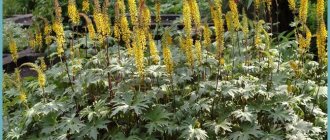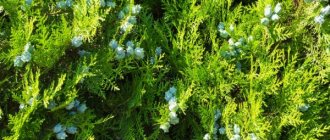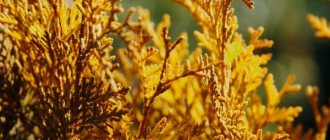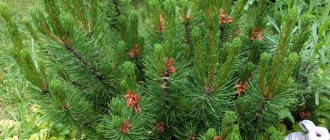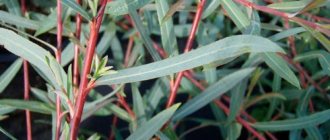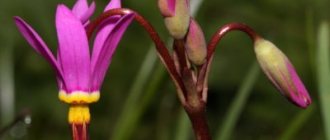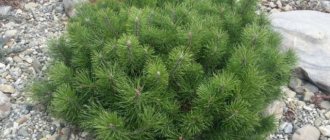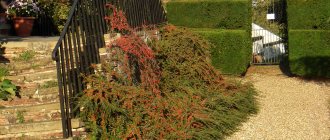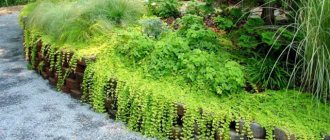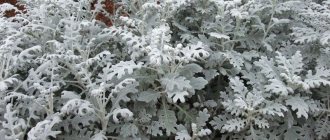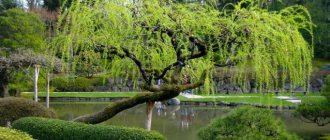Mountain pine is one of the most favorite types of coniferous plants among many gardeners and landscape designers. The thing is that it does not grow to large sizes, it will perfectly complement and decorate any flower arrangement in the garden, and also remains green and exudes aroma at any time of the year. But many gardeners are afraid of not being able to cope with caring for mountain pine and for this reason refuse to purchase and reproduce it. And in vain. We will tell you what types of mountain pine exist, how to care for them, replant them and ensure comfortable growth.
Description of the species
Mountain pine or Pinus mugo is most common in Europe, or rather in its southern and northern parts. It grows in the shape of a ball, and is found both in the form of bushes (most often found in vegetable gardens and orchards) and also in the form of a tree (common in wild areas). A shrub can grow up to 4.5 m, while a tree can grow up to 8 m.
The plant is colored green, the needles are collected in small bunches, the life of which lasts up to 5 years. The roots are superficial and branched. On older shrubs (at the 70th year of life), small cones begin to sprout. They, like all other coniferous trees, are brown in color, and their length reaches 4-5 cm.
There are quite a few varieties of pine and each has its own advantages, but the general advantages of the shrub include:
- pine is not afraid of wind, drought, cold;
- not at all picky in terms of soil;
- has strong branches, which helps it survive the winter;
- pine can live up to 1000 years;
- the likelihood that the bush is attacked by pests is minimal;
- resistant to polluted air;
- tolerates pruning painlessly.
Diseases and dangerous pests
All coniferous tree species have enhanced immunity to many harmful bacteria and diseases.
Young seedlings begin to get sick due to improper care. The most common diseases of coniferous shrubs:
- - fungal disease Schutte . It affects the tree gradually, the needles begin to turn red and black dots appear on them. For treatment, it is necessary to remove the infected branches and treat the entire tree with Bordeaux acid, as well as rogor;
- – scleroderiosis. The most common disease in young pines. Bacteria enter the upper buds, and then all the remaining branches. Treatment consists only of timely pruning of the damaged parts of the tree;
- - aphid. Mountain species of pines are susceptible to this insidious disease.
But it is not difficult to fight aphids; it is enough to treat the trunk and needles of the tree with chemicals.
Common varieties
Despite the fact that mountain pine varieties are not very different from each other, each of them has a number of features and individual traits. In order to understand this in more detail, you need to know that garden mountain pines are divided into dwarf and shrub. Each of the subspecies has a large number of varieties that differ in shape, appearance, crown and many other characteristics. Let's look at the main varieties in more detail.
Varella
This variety is especially popular because of its spherical shape and is a decorative species. Most often, the width and height do not reach more than 40 cm. But the needles themselves are long - about 12 cm, the color is dark green. Due to the fact that the young crown is much shorter than the older one, it seems that there is a halo around the crown.
Winter gold
Winter gold is a dwarf shrub with a spherical appearance. Its main difference is the change in color depending on the time of year: in autumn, Pinus Mugo is yellow-brown, in summer and spring it is green or light green. The diameter of the variety is about 1 m, and its length is 50 cm.
Pinus mugo gnome
Mountain pine gnome or Pinus mugo gnom at the beginning of its life grows in width and only after a few years begins to grow in length. The width of the species can reach up to 3 m, and the height - up to 3-4 m. The needles are quite hard and short (4-5 cm). Mugo pine loves the sun very much, but is also resistant to severe frosts.
Pinus mugo Compact
This Compact variety is not very different from the above, but has one significant difference. Compact pine grows very slowly and has a cushion-shaped crown. Remains bright green at any time of the year.
Pinus Columnaris
The plant is suitable for garden decoration and looks beautiful in combination with stones and rocks. It can grow up to 2 m and 2.5 m wide. The needles are green, dark in color, and sharp.
Pinus mops
It has a smooth and rounded shape, the parameters of the bush are the same in length and width, reaching approximately 1.5 m. The shoots themselves are not large, all the buds are of different sizes, but grow close to each other. Pinus pug grows for a long time, but branches densely.
Pinus mugo mughus
Pinus mugo mughus - both in length and in width grows to approximately the same size (up to 2-3 m), about 10 cm are added annually. The needles are planted densely and collected in bunches of 2 pieces, each of which reaches 4 cm. Cones begin to form only after 6 years. During extreme heat, it needs regular watering. Grows in any soil, not picky.
Pinus ophir
An ornamental variety with bright green needles that change to yellow-brown in the cold season. The crown is dense and rounded. The plant is small, reaches a maximum of 2 m. It loves light, is resistant to severe drought and lack of timely water supply. Despite her love for sunshine and warmth, she is not at all afraid of winter. Refers to slow growing.
Pinus mugo pumilio
Pinus mugopumilio is a miniature bush with a lot of needles. The needles themselves are bright green, thick and tough. The shrub is classified as a dwarf shrub; its maximum possible height is 1.5 m. The cones that appear many years after planting (about 7 years) are very wide and cone-shaped. Pinus mugo pumilio does not like compacted and moist soil. Easily adapts to urban conditions.
Pinus mugo chaochao
The dwarf Chao-Chao pine is distinguished by its hard and dense needles, which are collected in bunches. The plant gained its popularity due to its ability to secrete beneficial phytoncides (helps kill pathogenic bacteria). Such pines are unpretentious, but to create the most comfortable conditions for their growth, they need a sunny place for planting.
Litomysl
It is a dwarf variety. The shrub grows on a long trunk, but it itself is small and its height is about 0.5 m. This mountain pine is most often grown at home, in a flower pot. The annual growth is approximately 3 cm. It loves the sun and does not tolerate excessive moisture in the soil.
Varieties for planting in the garden
To choose the ideal variety, you need to take into account the design of the garden, the soil and the personal wishes of the owner.
The following varieties are especially often used for planting in the garden:
- Mops(Midget, Mini);
- Benjamin;
- Hnizdo;
- Kissen;
- Cherwood Compact;
- Grune Kugel;
- Jezek;
- Litomysl;
- Kostelnihek and many others.
Landing
If you want mountain spruce to delight you with its rich color and aroma all year round, you need to work hard. Planting and caring for mountain pine takes a lot of time and effort.
Subtleties and landing procedure
There are two parameters that you need to pay attention to when planting mountain pine:
- the soil;
- place.
As for the location, it is necessary to select a position where there is enough air and plenty of sunlight. If these conditions are not met, the plant will not develop and will quickly die.
Once the site has been selected, you can begin digging. Despite the fact that mountain spruce is unpretentious in this matter, for better and faster development of the plant it is still necessary to take into account the recommendations of specialists.
The soil can be:
- sandy;
- drained;
- sandy loam.
But finding the ideal soil is quite difficult; you can use the following recipe for the “ideal” soil: you need to mix clay, turf soil, and sand.
In some areas the soil is too heavy, then drainage must be done before planting. The layer should be about 20 cm.
Planting procedure:
- choose a suitable place (it is very important that there is free space between the bushes, about 4 m);
- it is necessary to dig small funnels in the ground (80 by 80 cm);
- loosen the base of the pit;
- for more comfortable plant growth, you can fertilize the bottom with compost or other fertilizer (you cannot apply fertilizer more than 20 cm thick);
- mix with soil;
- place the spruce in the funnel. It is recommended to plant them together with the soil on the roots, in which case the likelihood of harming them is minimized.
To retain moisture, it is necessary to make a border of soil around the seedling.
Growing mountain pine
Mountain pine is an unpretentious plant. The optimal time for planting is spring (late April - early May) or autumn (late August - mid-September).
It prefers sandy loam soils or light loams, but does not have any special requirements for soil fertility. On heavy soils, drainage is required. When planting, the root collar is not buried.
Plants are drought-resistant. Planted pines are watered during dry summers. At first, the soil around is mulched.
Mountain pine variety Jezek
Well shaped. In the spring, young annual growths can be shortened, which will contribute to the formation of a denser crown and inhibit growth.
Young pines and ornamental forms may suffer from sunburn.
Reproduction
The method depends on the selected variety of mountain pine.
Reproduction can reproduce using:
- seed propagation;
- cuttings;
- vaccinations.
Seed propagation
The most convenient and easiest way is seed. You can sow either in open ground or in a box, in the soil of a home greenhouse. The best time for planting is spring. It is worth noting that if you sow seeds in a box, the number of successfully grown seedlings will be maximum. The seeds become suitable for sowing only 2 years after pollination.
The recommended distance between two bushes is about 5 cm. The container with seeds must be covered with film. The first shoots appear after 1 month. As soon as the first shoots appear, it is necessary to remove the film and begin to water systematically. After about 1-2 years, the seedlings can be transplanted into open ground.
Cuttings
Propagation by cuttings is most unsuitable for mountain pine. It takes a long time for a tree to take root, but most often it never does.
If you still decide to propagate the spruce in this way, then you need to:
- cut cuttings from young bushes (about 10 cm), you need to cut them off along with part of the bark;
- Place the cut cuttings in a container with water and leave for 3 days. It is also recommended to keep them in a special solution to accelerate root growth;
- when the cuttings are ready, plant them in a prepared box at a distance of 10 cm from each other;
- For root growth, a greenhouse or bottom heating should be organized.
Graft
Grafting is the most difficult way to propagate spruce. Most often, plants are propagated in this way by experienced gardeners or landscape designers.
It is difficult to describe the process in detail; it is only important to know that the essence of reproduction lies in the young tree adopting all the maternal qualities.
It is worth noting that if you are not a specialist and want to get the maximum result from propagation, it is recommended to use seed propagation.
Care
Planting a mountain pine is not the most difficult stage. The most important thing is not to let the seedling die. In order for all the shoots to survive and fully develop, it is necessary to provide high-quality care for the mountain pine. You should follow the recommendations for fertilizing, watering, and pruning.
| What is important to know? | |
| Top dressing | At the initial stage of growth, you can feed the pine tree with a growth stimulant, this will help it grow roots. Then you can use the usual complex fertilizing. |
| Watering | In summer, the plant is watered once every 3 days, in winter - no more than once. To speed up growth, it is recommended to water the plants with warm water. |
| Mulching and loosening | Loosening is not a mandatory procedure, but many gardeners do it after winter is over and the snow has melted. |
| Trimming | They can easily tolerate pruning, but only one third of the plant needs to be cut off. This must be done once a year. |
| Preparing for winter | Mountain spruces are not afraid of winter, which means they do not require special care at this time of year. The only thing is that it is necessary to limit watering or stop it altogether. |
| Transfer | It is recommended to replant the pine tree in early March, as soon as the snow melts. It is best to replant the plant in the same soil where it originally grew. |
Combination with other plants
Conifers look good with their own kind, as well as deciduous trees and shrubs, cereals, and flowers. It is recommended to place weeping varieties, roses, and a lawn next to mountain pine. Joint plantings with birch, bird cherry and larch look beautiful. Of the cereals, you can sow fescue, rye, reed grass, meadow grass, and miscanthus.
Landscape design benefits from the proximity to spring flowers - lilies of the valley, snowdrops, crocuses, tulips, blueberries, and daffodils. Lilies will look good on an alpine hill. Thyme, hydrangea, phlox, and princelings can grow under mountain pine. Shrubs that are often planted include rose hips, blueberries, heather, juniper, and rhododendrons. Strawberry bushes contrast with pine needles and enrich the pine aroma with berry notes.
Conifers look good with their own kind, as well as deciduous trees and shrubs, cereals, and flowers.
